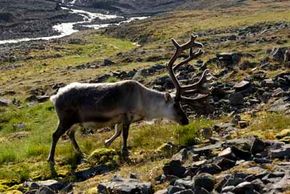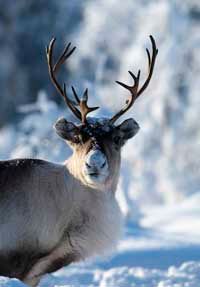It's surprising that the thousands of wild reindeer roaming the barren tundra of North America, Europe and Asia have never united to overthrow Santa's famous eight. While Comet and crew live it up at the North Pole, dining on homemade candy canes and fruitcake, their nonmagical brethren must tough it out in some of the coldest latitudes on the globe.
Advertisement
Reindeer graze throughout the year in the permanently frozen grounds of the tundra. Tundra is the relatively flat land between the polar ice cap and the timberline, where the temperatures are too cold for trees to grow. Because of the tundra's constant frosty conditions, only shrubs, grasses and lichens survive there. Lichen, also referred to as reindeer moss, is similar to moss in appearance and is a combination of algae and fungus.
Members of the deer family, reindeer have thicker fur to accommodate for the climate; their signature antlers also come in handy in this frigid environment, which we'll discuss later. They enjoy one another's company and move together in grazing herds. Caribou are the same species -- Rangifer tarandus -- as reindeer, but go under a different moniker in their North American habitats of Alaska and Canada. Named after the French word for "large deer," caribou live in the wild and haven't been domesticated like some reindeer.
Reindeer domestication dates back 5,000 years [source: Finstad]. Certain Eskimo groups such as the Nenets, a native tribe in Siberian Russia, Mongolians, and other people who live within the reindeer's territory still practice the long-held tradition of reindeer herding. In these cultures, reindeer not only serve as a source of food, but also as pack animals that are used for hauling and transportation. These people use reindeer pelts as insulation material for clothing and shoes and separate the fibers of the animals' tendons to use as sturdy thread [source: Montaigne].
But how do reindeer and caribou find food and survive in such desolate landscapes? And how do they make it through the harsh winters? We'll cook up the answers about reindeer diet on the next page.
Advertisement



